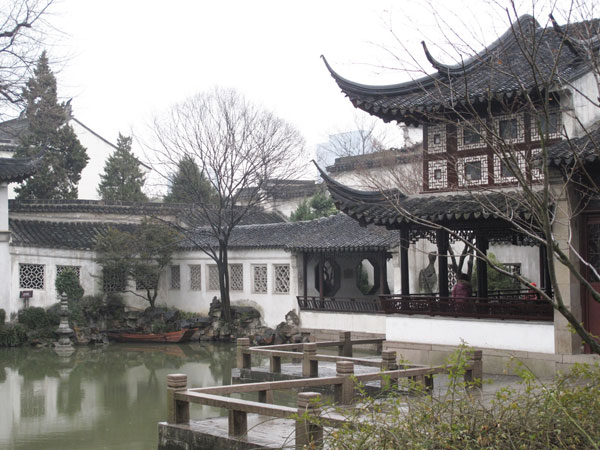A place to leave behind worldly turmoil, and linger in serenity
Updated: 2013-03-28 00:19
By Raymond Zhou (China Daily)
|
||||||||
 |
|
The architecture next to the pond provides a backdrop of quiet splendor when viewed from the other side. Raymond Zhou / China Daily |
To say the Lingering Garden is a typical Suzhou garden is like saying Coca-Cola is a typical soft drink. All classical gardens in Suzhou share the same style.
A first-time tourist need visit only one, but a discerning traveler may be able to detect the nuances that differentiate each one.
Now I'm no connoisseur in garden landscaping, so I'll offer my personal opinion, which is totally subjective.
The best spot in this 400-year-old garden is the hexagonal-roofed pavilion on top of the very small hill. From here, you can take in the view of the pond, with the houses in the background. The angle is roughly that from a treetop, but it puts the water in proper perspective, right in the middle of your mental frame, neither too big nor too small.
Perspective is not used in traditional Chinese painting, which rarely separates foreground and background. But a Suzhou garden resembles a Chinese scroll only when examined from a bird's-eye view. At ground level, it is more like a Western landscape, but with ever-shifting foregrounds and backgrounds.
The slightly elevated viewpoint from the mound provides a kind of in-between state. If you brush away plants and twigs, it's more Chinese; if you gaze behind the pillars of the pavilion, you gain a foreground.
Tiptoeing down the hill into the back garden gives me the best feeling about this urban oasis.
It's not the priceless gingko trees, but the pebbled path that stimulates a special tingling in my feet. It can be slippery when wet, yet it provides enough traction to keep balance. The intricate patterns of varying shades of gray are the visual equivalents of New Age music — stimulating and mesmerizing at the same time.
The pond, with its de rigueur rockeries and red fish jostling for food, is a natural hub for tourists. Unless you come on an early morning or a drizzling day, it is a spot for people watching as well.
To get away from the crowd, I aimlessly wandered the back garden along its long corridor. The scenery here is less intense. You don't feel the need to capture every step with a click of the camera.
If crowds are thin, the walk through the main building - from the main entrance to the pond side - should be slowed down and absorbed.
Hopefully this is not done in winter, because this part of China does not have central heating and the houses were so obviously designed for maximizing summer cool. The buildings and rooms are more closely connected than a typical courtyard house or a temple compound. Some of the passages appear quite dim, with a tiny yard inducing a shaft of light.
It is difficult to define the hierarchy in this kind of design aesthetic. But as an abode for a retired official, which was the case with the estate's many owners, it reflects the mentality of the mature and the sophisticated.
You may not want to raise your kids here, but you have a hunch that local Marcel Prousts would find it comfortable to compose their multi-volume tomes and be immune from the hurly-burly of the fast-changing world beyond the brick wall.

 'Taken 2' grabs movie box office crown
'Taken 2' grabs movie box office crown
 Rihanna's 'Diamonds' tops UK pop chart
Rihanna's 'Diamonds' tops UK pop chart
 Fans get look at vintage Rolling Stones
Fans get look at vintage Rolling Stones
 Celebrities attend Power of Women event
Celebrities attend Power of Women event
 Ang Lee breaks 'every rule' to make unlikely new Life of Pi film
Ang Lee breaks 'every rule' to make unlikely new Life of Pi film
 Rihanna almost thrown out of nightclub
Rihanna almost thrown out of nightclub
 'Dark Knight' wins weekend box office
'Dark Knight' wins weekend box office
 'Total Recall' stars gather in Beverly Hills
'Total Recall' stars gather in Beverly Hills
Most Viewed
Editor's Picks

|

|

|

|

|

|
Today's Top News
Boston bombing suspect reported cornered on boat
7.0-magnitude quake hits Sichuan
Cross-talk artist helps to spread the word
'Green' awareness levels drop in Beijing
Palace Museum spruces up
First couple on Time's list of most influential
H7N9 flu transmission studied
Trading channels 'need to broaden'
US Weekly

|

|







